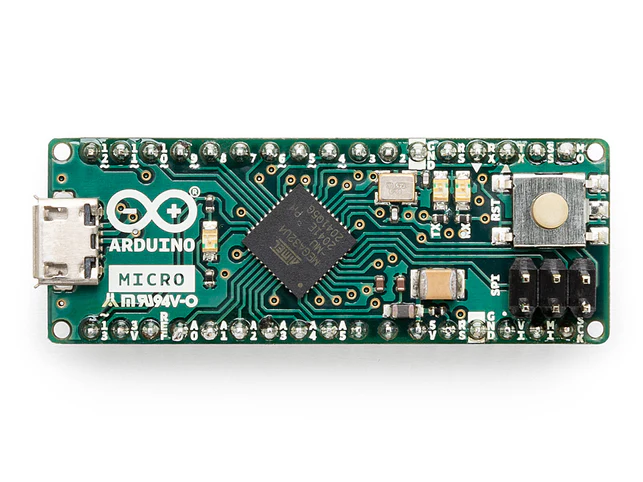The Arduino Micro is a compact and versatile board in the Arduino family, designed to provide a smaller form factor while maintaining many of the capabilities of larger Arduino boards. Here are the key features and details about the Arduino Micro:

- Microcontroller: It uses the ATmega32u4, which is the same microcontroller found in the Arduino Leonardo. This microcontroller integrates USB communication capabilities directly, allowing the board to act as a USB device without the need for an external USB-to-serial converter.
- Memory:
- Flash Memory: 32 KB (ATmega32u4) of which 4 KB used by the bootloader.
- SRAM: 2.5 KB
- EEPROM: 1 KB
- Operating Voltage: 5V
- Input Voltage (recommended): 7-12V
- Digital I/O Pins: 20 (of which 7 provide PWM output)
- Analog Input Pins: 12
- DC Current per I/O Pin: 40 mA
- DC Current for 3.3V Pin: 50 mA
- Clock Speed: 16 MHz
Key Features:
- Size: The Arduino Micro is significantly smaller than the Arduino Uno, making it ideal for projects where space is at a premium or for embedding into smaller devices.
- USB Communication: Similar to the Leonardo, the Micro can emulate HID devices like keyboards or mice, offering unique capabilities for USB-based projects.
- Pin Mapping: It shares the same pin mapping and functionality as the Leonardo, including the ability to use D0 and D1 for other purposes since they’re not tied up with serial communication.
- Power: Can be powered via the micro USB port or with an external power supply through the Vin pin, automatically selecting the highest voltage source.
- Programming: Fully compatible with the Arduino IDE, making development straightforward for users familiar with Arduino.
- Design: The board includes an onboard voltage regulator, a reset button, and headers for easy breadboard connection. However, due to its size, it uses micro USB instead of the standard USB-B found on the Uno.
Unique Capabilities:
- HID Emulation: Like the Leonardo, it can act as a keyboard, mouse, or other USB device, making it ideal for projects involving USB peripherals or custom USB functionality.
- Reduced Complexity: The integrated USB communication simplifies the design, reducing the number of components and potentially lowering the cost.
- Lower Latency: Direct USB communication can provide lower latency than boards with separate USB-to-serial chips.
Use Cases:
- Portable Projects: Due to its small size, it’s excellent for portable or embedded projects.
- USB-Based Applications: It’s particularly well-suited for applications where direct USB communication is needed, like emulating input devices or creating custom USB peripherals.
- Education: Its compact form factor and full functionality make it a good choice for educational settings where space or portability is a consideration.
The Arduino Micro offers a blend of the Arduino Uno’s capabilities in a much smaller package, making it an attractive choice for projects where size matters without sacrificing functionality or ease of use.
Related Boards
If you are looking at upgrading from previous Arduino designs, or if you are just interested in boards with similar functionality, at Arduino you can find:
- Arduino Leonardo
- Arduino Micro without headers
- Arduino Nano
- Arduino Nano 33 BLE
- Arduino Nano 33 BLE Sense
- Arduino Nano 33 IoT
Getting Started
Find inspiration for your projects from our tutorial platform Project Hub.
You can find in the Getting started with the Arduino Micro section all the information you need to configure your board, use the Arduino Software (IDE), and start tinkering with coding and electronics.
From the Tutorials section you can find examples from libraries and built-in sketches as well other useful information to expand your knowledge of the Arduino hardware and software.
Need Help?
Check the Arduino Forum for questions about the Arduino Language, or how to make your own Projects with Arduino. Need any help with your board please get in touch with the official Arduino User Support as explained in our Contact Us page.
Warranty
You can find here your board warranty information.
Tech specs
| Microcontroller | ATmega32U4 |
| Operating Voltage | 5V |
| Input Voltage (recommended) | 7-12V |
| Digital I/O Pins | 20 |
| PWM Channels | 7 |
| Analog Input Channels | 12 |
| DC Current per I/O Pin | 20 mA |
| DC Current for 3.3V Pin | 50 mA |
| Flash Memory | 32 KB (ATmega32U4) of which 4 KB used by bootloader |
| SRAM | 2.5 KB (ATmega32U4) |
| EEPROM | 1 KB (ATmega32U4) |
| Clock Speed | 16 MHz |
| LED_BUILTIN | 13 |
| Length | 48 mm |
| Width | 18 mm |
| Weight | 13 g |
